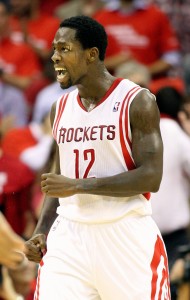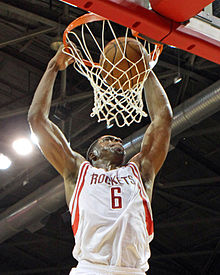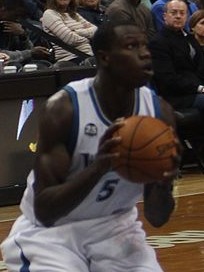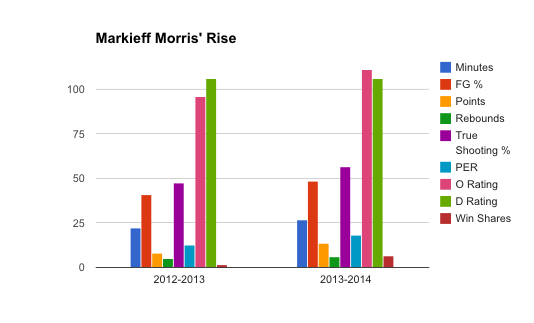 On Thursday, we gave you our All-Breakout Team for the upcoming season for the Eastern Conference.
On Thursday, we gave you our All-Breakout Team for the upcoming season for the Eastern Conference.
Today, we bring you our Western Conference All-Breakout Team. These are the players we believe are on the verge of breaking out or standing out.
We used the same parameters – five players, one at each position, but no rookies.
Let’s get right to it.
Patrick Beverley, PG, Houston Rockets
Beverley’s defensive exploits have been well-documented, leading to his placement on the NBA All-Defensive Second Team despite playing in just 55 games. He brings high energy and intensity on every possession to the delight of fans and to the detriment of opponents, most notably Russell Westbrook.
However, Beverley’s 108 defensive rating is a bit misleading because Houston’s fifth-ranked offensive pace, a team’s possessions per 48 minutes, causes it to lose out a bit on the defensive end. It is his offensive game where his breakout season could occur.
Beverley shot 41.4 percent from the field, 36.1 percent from the arc and had very good true shooting and effective field-goal percentages for a point guard. They were similar to his 2012-13 rookie season despite playing nearly 14 more minutes per game. Another underrated factor is his offensive efficiency. Although Beverley didn’t log enough minutes to qualify among the league leaders, his 115 offensive rating last season was better than star point guards John Wall, Kyrie Irving and Tony Parker.
With Isaiah Caanan essentially replacing the departed Jeremy Lin as the team’s backup point guard and Omer Asik and Chandler Parsons now elsewhere, the stage is set for Beverley to take on more offensive responsibilities and make the next progression in his game. If he brings that trademark intensity to both sides of the floor, there’s no reason why he should not succeed.
Draymond Green, SG, Warriors
We’re stretching things a bit here, because Green is a forward. However, he can defend shooting guards. Like Beverley, he is another player known for his defensive prowess that could make a jump on the other end.
From an offensive standpoint, the 2013-2014 season was an it-can-only-go-up-from-here year for Green. His overall shooting percentage increased eight percentage points – to 40.7 percent. His 3-point percentage rose an impressive 12.4 percentage points – to 33.3 percent. We could discuss Green’s shooting progression from abysmal to below average even more, but we’ll digress.
Green not only improved his defensive rating to 97.7 (fifth in the league behind only Tim Duncan, Paul George, teammate Andrew Bogut and Joakim Noah) but more impressively scored 15 more points per 100 possessions last year (102) than his rookie season.
Green will always be a top notch defender; in addition to his defensive rating, he also was seventh in steal percentage at 2.8. But his offensive game has the ability to take another quantum leap and earn him a whole lot more respect around the league.
Terrence Jones, SF, Rockets
 Many have called the Houston’s offseason an abject failure, and there’s certainly a case to back that up, But Terrence Jones is someone well-positioned and well-equipped to soften the losses on this roster. Parsons, Asik and Lin are out and Trevor Ariza and Jason Terry will be joined by Jones and his larger role.
Many have called the Houston’s offseason an abject failure, and there’s certainly a case to back that up, But Terrence Jones is someone well-positioned and well-equipped to soften the losses on this roster. Parsons, Asik and Lin are out and Trevor Ariza and Jason Terry will be joined by Jones and his larger role.
Jones’ 118.8 offensive rating ranked 12th in the NBA, and he rewarded Kevin McHale increasing his minutes in grand fashion. In just 27.1 minutes per game, he shot 54.2 percent to go with 12.1 points, 6.9 rebounds and 1.3 blocks. His 19.1 PER, plus-15 net rating, 7.3 win shares and .169 win shares per 48 minutes were all huge numbers.
Many would call last season a breakout for Jones, but his game can grow even further, as evidenced by his play after the All-Star break.
| T.Jones | MPG | FG% | PPG | RPG | BPG | True FG | ORate | DRate | NetRate |
| Pre-Break | 28.2 | 52.4 | 11.7 | 7.3 | 1.4 | 55.8 | 114 | 105 | 9 |
| Post-Break | 25.8 | 57.3 | 12.8 | 6.3 | 1.14 | 61.0 | 125 | 106 | 19 |
Houston outscored its opponents by 19 points per 100 possessions when Jones was on the floor after the break, a 10-point improvement. Jones’ shooting and efficiency become other-worldly; he even shot 34.4 percent from three compared to just 29 percent before President’s Day.
Jones will probably play 30-plus minutes this season, which is a good thing considering that in the 31 games last season in which Jones logged 30-39 minutes, he averaged 16.6 points and 9.5 rebounds on 55.2 percent shooting with an offensive rating of 127. He also shot 35.8 percent from three in those games.
The sky is truly the limit for Jones, who could have a jet-fueled ascent into the stratosphere of top frontcourt players.
Markieff Morris, PF, Phoenix Suns
There was a time where Markieff Morris was an undistinguished player — from his twin brother Marcus or any other potential-filled lottery pick destined for a flameout and a contract in Europe. Then last season happened. He has the ability to break out even further in 2014-2015. Just look at his year-to-year progression over the last two seasons.
| Markieff Morris | MPG | FG% | PPG | RPG | True FG% | PER | ORate | DRate | WS |
| 2012-2013 | 22.4 | 40.7 | 8.2 | 4.8 | 47.3 | 12.6 | 96 | 106 | 1.7 |
| 2013-2014 | 26.6 | 48.6 | 13.8 | 6 | 56.4 | 18.4 | 111 | 106 | 6.4 |
While playing just four more minutes per contest, the growth of Morris’ game is almost staggering. His field goal percentage went from below average to a very healthy 48.6. His PER and offensive efficiency went way up, and his per-game trips to the line more than doubled.
With Channing Frye now in Orlando, Morris should slide into the starting lineup, see more playing time and have a breakout season for the second straight year.
Gorgui Dieng, C, Minnesota Timberwolves
 We saw glimpses of the player Dieng could be while at Louisville, but his rookie encore was something to behold. Why get so excited over someone who averaged 4.8 points and 5.0 rebounds last season? Because he was an advanced stats monster and a true beast will be unleashed this season in Minnesota.
We saw glimpses of the player Dieng could be while at Louisville, but his rookie encore was something to behold. Why get so excited over someone who averaged 4.8 points and 5.0 rebounds last season? Because he was an advanced stats monster and a true beast will be unleashed this season in Minnesota.
For some inexplicable reason, Dieng played 13.6 minutes per game last season. But he shot 49.8 percent from the field with a very good 16.5 PER, a really good 100 defensive rating and an above average .129 win shares per 48 minutes.
With Nikola Pekovic as the starter, Dieng won’t play 36 minutes, but his per-36 minute numbers are simply bonkers: 12.6 points, 13.2 rebounds, 2.2 blocks, 1.3 steals and a “wow” factor that makes people excited for the new era of Twin Cities basketball.
The Wolves will build around Dieng, Pekovic, Andrew Wiggins, Anthony Bennett, Thaddeus Young and Ricky Rubio. On paper, that’s not bad. And with Dieng continuing his meteoric rise, Minnesota should actually be fun to watch next season.
Read the Eastern Conference’s breakout team here on SheridanHoops
Shlomo Sprung is a national columnist for SheridanHoops who loves advanced statistics and the way they explain what happens on the court. He is also the web editor of the Brooklyn Daily Eagle. A 2011 graduate of Columbia University’s Journalism School, he has previously worked for the New York Knicks, The Sporting News, Business Insider and other publications. You should follow him on Twitter.

Currently in the world of get together and exciting the Hookahs consist of turn out to be rather well-known. Anywhere on your own move you can watch a parlor of Bongs. However they are not just utilised for getting fun inside some puts Smoking cigarettes Pipes are on top of that utilized in direction of make a specific healthful and thoroughly in shape yet again.
I’ll tell you why Dieng only played 13.6 minutes per game. It was because Rick Adelman is an idiot and only played him late in the season after being forced to with Pekovic and Rhonny Turiaf shelved with injuries. Yes, he believe Rhonny Turiaf was better than Dieng.
Dieng should be the starter for the Wolves this year because he has acceptable offense and provides much needed defense. Pek should come off the bench with the second team and munch on backup centers.
Again, Adelman is an idiot and should have been fired years ago.